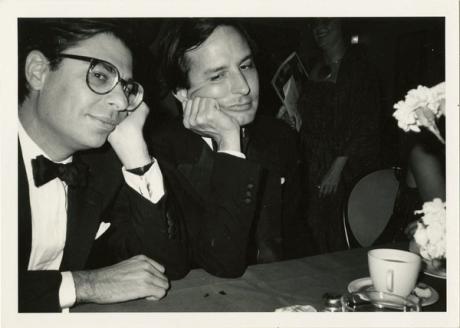
One of Andy Warhol’s closest friends, writer and photographer Bob Colacello, presents a series of photographs from the 1970s and 1980s capturing the people and parties of the time. It just happened 1976-82, a new exhibition in London at the Ropac Gallery (until July 29), includes images of Warhol with his artist peers, photos from parties at The Factory and Studio 54 and intimate shots of the Pope of Pop.
Colacello was the editor of Interview magazine, Warhol’s famous celebrity column, between 1971 and 1983. During one of his many trips abroad with Warhol, the young Zurich art dealer Thomas Ammann showed up in Andy’s hotel suite with the all-new Minox, the first miniature camera to take fully framed photos, says Colacello.
Colacello released the Minox to capture politicians, artists and confidants. “There’s a scarcity factor in all of these photos,” Colacello says. “Andy didn’t bring a professional photographer [on his trips]— they were taken in places where there were no photographers. I was part of the Warhol family, nobody cared that I took their picture.
This form of surreptitious photography is a kind of “amateur photojournalism”, says Colacello. Although “over time I started to realize that I knew what I was doing. I liked when someone unknown blocked someone very famous,” he says.
Photography was not considered an art in the 1970s, Colacello points out. “We made a piece in Interview in 1975, wondering is photography art? Photography was called an applied art, like fashion, it was not an art, like painting, sculpture, printmaking or drawing. The big breakthrough came when Richard Avedon had his exhibition at the Marlborough Gallery [late 1975]; It was then that we decided to do an issue on art and photography.
In the London drawing room, a wall of images shows a range of major 20th century artists, including Robert Mapplethorpe, Roy Lichtenstein and Robert Rauschenberg. “The truth is Andy wasn’t much admired by the New York art world in the 1970s…Jasper Johns despised him, Rauschenberg was a little nicer. Roy was a friend. Mapplethorpe and I were friends but he didn’t want to hang out with Andy because he said he would steal his ideas. And Andy hated him for saying that.
another picture, Andy’s Room Service Breakfast, Naples (1976), shows Warhol having breakfast in his Brooks Brothers shirt, Jockey shorts and Supp-hose socks in a Naples hotel. The vulnerability of the pop artist is striking. “Andy didn’t really like being touched,” says Colacello, who recalls a tense exchange in a hotel in Paris. “He was sleeping on his bed, so I slowly took off his boots. He yelled, what are you doing? He was protecting himself by holding a tape recorder in one hand and Interview in the other.”
Colacello also describes how the Ladies and gentlemen paintings – of black and Latina transgender women and drag queens painted by Andy Warhol in 1975 – have emerged. The works, presented at the Tate Modern in 2020were commissioned by Italian Warhol dealer Luciano Anselmo in 1974, who commissioned the artist to portray “amusing” drag queens.
Warhol then asked Colacello to find sitters, offering a $50 fee to each model. Colacello discovered potential candidates at New York’s Gilded Grape club near Times Square, a magnet for members of the trans community. Warhol took Polaroids of the models, then transferred the images to screen printing, completing the canvases by covering them with synthetic paints.
Anselmo said “I want you to do a series of drag queens but unsuccessful drag queens.”
Warhol said, “Bob has a big beard, he could be the role model.” So Colacello stepped in, dressing in drag in exchange for a Warhol artwork. But the experiment failed because Colacello “didn’t hold her hand like a drag queen”, according to Warhol. “As paintings, they are among Andy’s finest. They are very heavy; the color combinations are among the most daring. I love these paintings,” says Colacello.
Colacello studied international affairs at Georgetown University School of Foreign Service in 1969, then continued his film studies at Columbia University, New York. He started writing movie reviews for Voice of the village around the same time, which caught Warhol’s attention. “One evening around 7:30 p.m., I was having dinner [at my parents’ home in Long Island]the phone rings and this guy, Soren Agenoux, told me he worked with Warhol and was the editor of the new magazine Interview. Andy wanted to meet me, he had read my reviews.
“I was beside myself – oh my god Warhol wants to meet me. But my dad said, ‘I forbid you meet that bastard who makes movies about boys wanting to be girls. I’m going to break your legs , I will break your camera.’ But of course I was looking forward to running to Union Square to meet Warhol the next day.
But has his father mellowed? “Yes, when I was able to tell him that [former US vice president] Nelson Rockefeller came down to The Factory to buy paintings. Within a year, my parents were taking Andy and her boyfriend Jed Johnson out for spaghetti and meatballs on Sunday lunch.
Colacello says he is “a die-hard Republican. But I’m not a Trump Republican. I think American politics is in a very scary and depressing place; there are a lot of clowns and no chef. Ronald Reagan conservatism is about individual freedom. But how does he reconcile his political views in the seemingly progressive art world? “I am an iconoclast; in the art world, everyone is a Democrat so I’m going to be a Republican. In 2004 he published Ronnie & Nancy; Their path to the White House from 1911 to 1980.
